In part three of our Honda Motocross history recap, we are going to focus on models from 1990 through 1999.
In part three of our Honda Motocross history recap, we are going to focus on models from 1990 through 1999.
In case you missed part one or two, here are links to them for your reading pleasure.
For Honda MX Bike History Part 1: The 1970s click HERE
For Honda MX Bike History Part 2: The 1980s click HERE
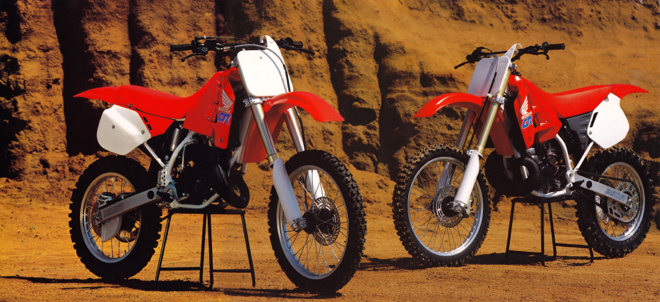 |
|
A white frame and switch back to the orange mist color of 1983-1987 gave the 1990 CRs a fresh appearance |
In 1990, Honda made a drastic change to the look of all the CRs with a move back to the orange-red of ’83 through ’87. In addition to the new (old) orange plastic, a new coat of white paint for the frame and the absence of a logo on the seat gave all the 1990 Hondas a radically changed appearance. On the 250, all-new bodywork smoothed the lines and improved ergonomics, while an all-new motor for the 125 boosted the ponies on the power-monger of the ’89 125 class. All three of the full-size CRs gained new Showa inverted forks (a first for the 125) and revised rear dampers in the hopes of erasing the poor suspension reviews of ’89.
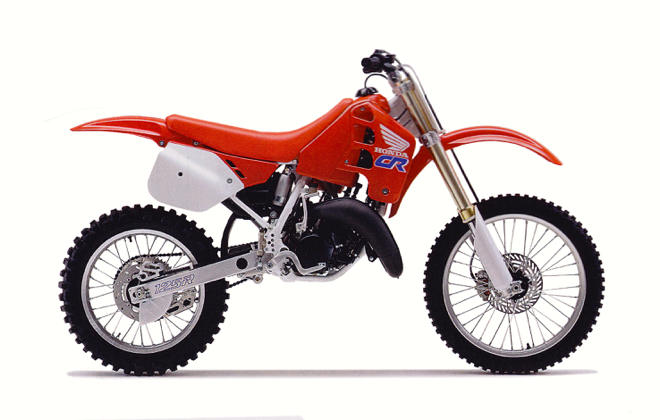 |
|
1990 Honda CR125R: An all-new HPP motor for the 125 boosted power for 1990 |
On the CR125R, the big news was the retirement of the engine that had ruled motocross from 1987 through 1989. On the new motor, Honda finally ditched their ATAC (Automatic Torque Amplification Chamber) exhaust valve in favor of a true-to-life variable exhaust port. Using a scaled-down version of the HPP (Honda Power Port) system found on the 250, the new 124.8cc mill kept the ear-splitting top-end of ’89, but beefed up the low-end and midrange considerably. With its tall stock gearing and top-end-focused power, it was still a better fit for skilled riders, but at least novices now had a shot at keeping it on the pipe.
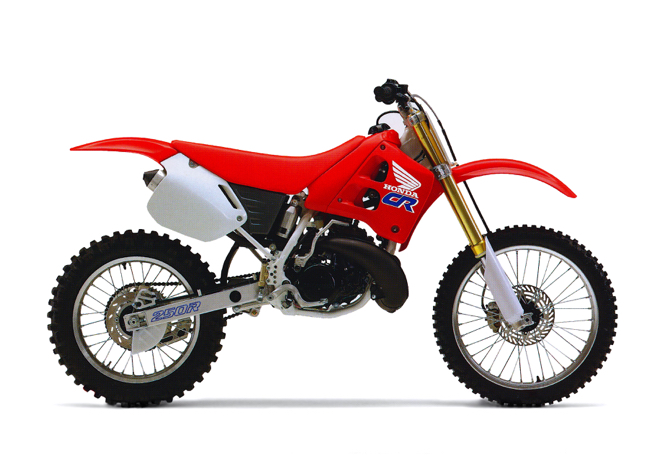 |
|
1990 Honda CR250R: Motor from Zeus, forks from Hades |
On the 250, the new bodywork kept the lowboy layout of ’88-’89, but smoothed the seat/tank juncture, streamlined the midsection and flattened out the saddle for superior rider movement. The HPP motor remained largely unchanged, but small porting alterations boosted torque and broadened the already potent powerband. The new 45mm Showa inverted forks and Showa shock worked marginally better than the year before, but remained the worst in the class by a wide margin.
 |
|
1990 Honda CR500R: New porting specs turned the mighty 500 from a Top-Fueler to a tractor for 1990 |
With the CR500R, Honda stuck to only minor mods after a major redesign in 1989. The motor remained devoid of any exhaust gismos, but still produced one of the most potent powerbands on the track. Minor porting changes for 1990 boosted torque and addressed rider’s complaints about the ’89 being too violent and hard to manage. The new powerband was much smoother and torquier than 1989. As in 1989, the 500 offered the best suspension package of the three full-size bikes, but it was still no match for the superior units found on the KX500.
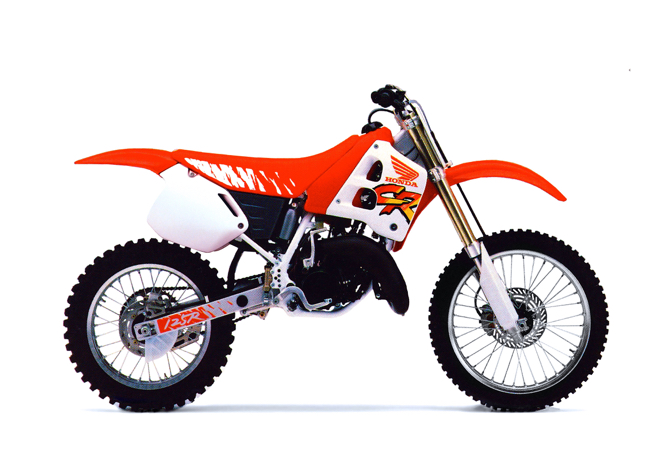 |
|
1991 Honda CR125R: New bodywork and a safari paint job for the 125 |
The early 90’s were an odd era for motocross styling. After several decades of fairly conservative colors and graphics, the entire motocross industry seemed to simultaneously flip their collective wigs. Suddenly KTMs were mint green, Yamahas were pink and Suzukis were every color in the kaleidoscope. Even conservative Honda was not immune to this flurry of questionable taste, as the entire CR line sprouted tiger stripes and gaudy graphics for 1991. I have no idea why someone in Japan thought this was a good idea, but it certainly made the 1991 CRs look unique.
Other than the new look, the changes across the Honda line were pretty minimal for 1991. New forks for all the big bikes featured an Aluminite coating to reduce oil contamination (a major problem in 1990) and larger-diameter cartridge units to improve damping. While a switch to Kayaba for the rear suspension on the 250 and 500 (the 125 already used a KYB damper in 1990) gave some hope that the 250’s ten-year run of sup-par outings might finally be at an end. Both the 125 and 500 adopted the larger airbox and streamlined look of the 250, while only the 125 inherited the revamped tank and shrouds of the 250.
In terms of performance, none of the CRs were greatly changed from 1990. With new bodywork and a slight alteration in chassis geometry, the 125 was easier to move around on and sharper turning (but no more stable). With the 125 motor largely a carryover, it remained the rocket it had been the year before, but revised carburetor settings and a new ignition led to an annoying a case of the “pops” on top-end. Thankfully, the popping did not seem to really affect performance and the CR remained the fastest 125 in the class. On the suspension end, the red tiddler once again trailed its competition with harsh action front and back. The new settings were a tiny bit better than 1990, but only enough to raise it from abysmal to downright awful.
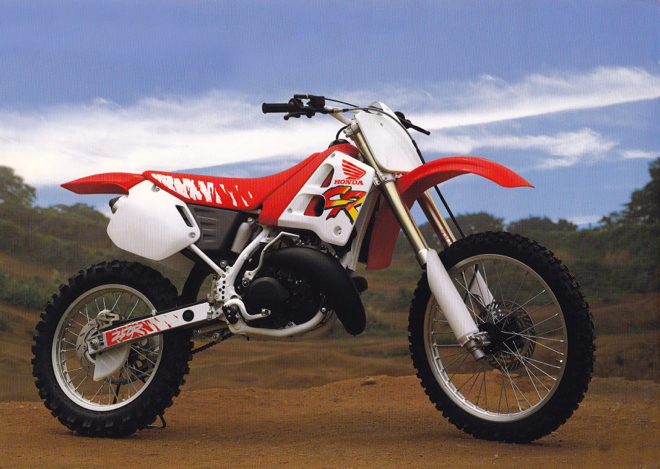 |
|
1991 Honda CR250R: What runs like a cheetah, looks like a tiger and rides like a donkey |
With the 250, Honda chose to not mess with success and literally left the majority of the bike alone for 1991. The motor, chassis and bodywork were unchanged (with the exception of the white shrouds and Tigger graphics), offering the same fit and feel as the year before. Even without modification, however, Honda’s omnipotent HPP motor remained the best in the class. With its smooth delivery and incredibly broad powerband, it was both the fastest machine and the easiest to ride. As on the 125, the 250’s new suspension was only a minor improvement over 1990. Harsh and unforgiving, it proved to once again be the major weakness in an otherwise excellent package.
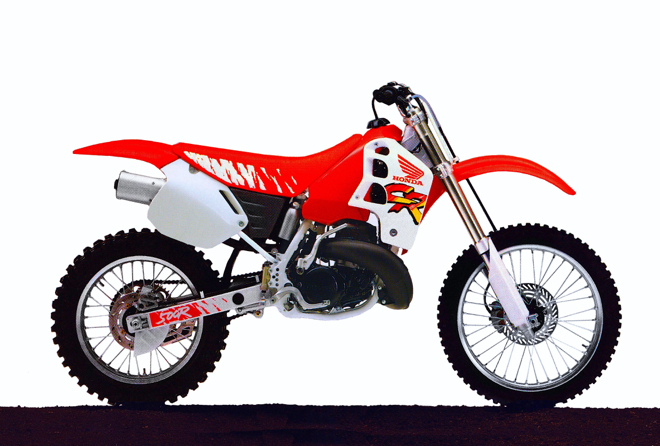 |
|
1991 Honda CR500R: One last bit of cosmetic surgery for an old friend |
In the Open class, the CR500R’s new rear section would prove to be the last major bodywork redesign the big five honey would receive. While the new rear plastic was a welcome cosmetic change, the lack of the 125/250’s new slimmer tank and shrouds were a bummer. Even with the old tank, however, it remained far less bulky feeling than the KX500. With very few other changes for ‘91, the 500 remained very much the same bike it was in 1990. Power was broad and potent and the handling was excellent as long as high-speed desert work was not in your plans. As before, the Showa suspension was livable, but not loveable.
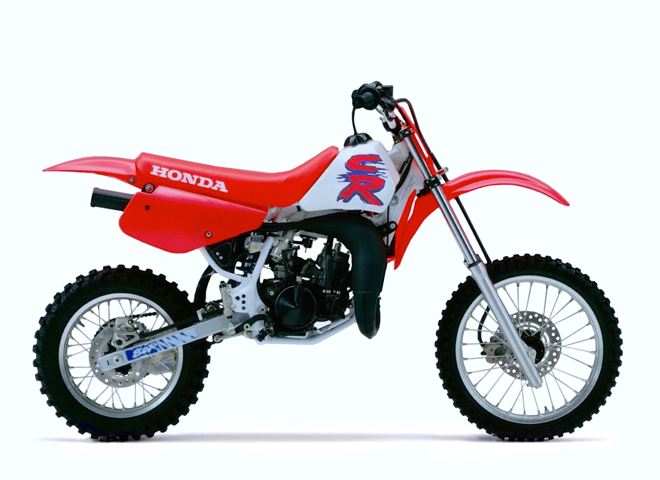 |
|
1992 Honda CR80R: A rear disc brake and Bold New Graphics |
The big Honda news for 1992 was a total redesign for the CR250R. A clean-sheet design, the new bike featured an all-new motor for the first time since 1986. The new mill did away with the successful but complicated HPP system and replaced it with a new design that used 50% less moving parts. The new Composite Racing Valve (CRV) promised comparable performance to the HPP, with much easier maintenance. In addition to the new motor, a new frame was spec’d and mated to radically redesigned bodywork that was both sleeker and bolder than ever before. With its “Nuclear Red” plastic, silver motor and white tank, the ’92 CR certainly looked like no other Honda before.
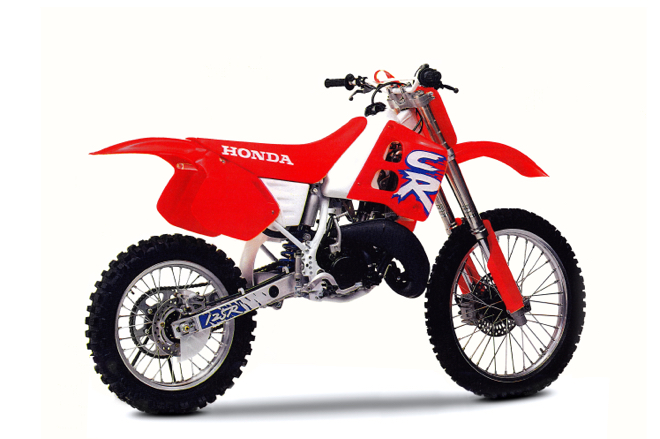 |
|
1992 Honda CR125R: A radical change in color scheme made the ’92 CR125R look newer than it really was |
On the track, the new CR250R’s performance was just as new as its looks. The redesigned motor was less smooth and far more abrupt than the ’90-’91 mill had been. Power was somewhat lacking down low, before ripping into a blistering midrange blast. While not necessarily faster than 1991, it was certainly more exciting to ride. The new chassis both steepened the head angle and shortened the wheelbase for ’92. This, combined with the new sleeker bodywork made the CR an absolute scalpel in the turns. Compared to the already sharp ’91, the ’92 felt like a 125 in the corners. At speed, the CR continued to be a handful and many riders (including Team Honda) took to adding bracing to the frame and swingarm to dial in more stiffness and reduce flex. On the suspension front, the new Showa forks and shock proved once again to be a disappointment. Poorly set up and harsh, they continued Honda’s five-year string of last-place suspension finishes.
 |
|
1992 Honda CR250R: Sleek, slim and Supercross bred |
On the CR125R and CR500R, the changes were far more minimal for 1992. Both received the Nuclear Red plastic and white tank of the 250, and all three full-sized machines adopted new front braking systems that improved power and feel. On the 125, a change in fork offset and a slightly shorter wheelbase further tightened turning, while a new head and flat-top piston aimed to beef up the midrange. While the new motor specs improved the CR’s torque slightly, the new piston design proved fragile and many riders switched back to the domed piston and head of 1991. The new 43mm Showa forks proved slightly less harsh and offered more adjustability, but continued to be the weak link in an otherwise winning package.
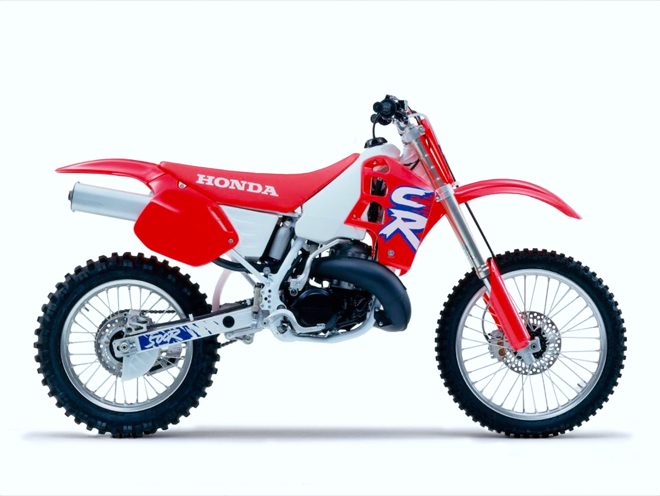 |
|
1992 Honda CR500R: A jumbo silencer and taller gearing further tamed the beast for ’92 |
On the 500, the only real changes were the new front brake, a taller final drive ratio and a new jumbo-sized silencer. While those changes seemed minimal, they actually made a significant difference in the 500’s performance. The longer silencer and tall gearing made the power from the big 491cc single feel much less violent and most riders really liked the change. There was slightly less torque to the rear wheel, but the bike was far easier to manage. That, combined with a more powerful front binder and slightly better suspension, made the ’92 CR500 a much-improved machine.
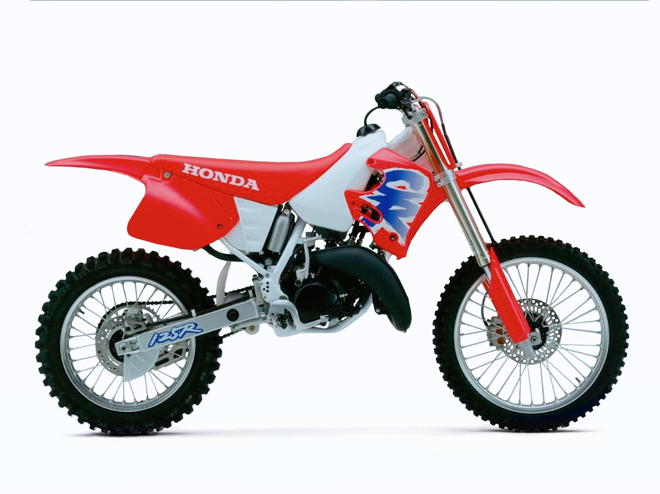 |
|
1993 Honda CR125R: All-new bodywork and a revised frame for the horsepower champ of the 125 class |
For 1993, the CR125R was the recipient of the lion’s share of changes in the Honda lineup. The motor was largely unchanged, but almost everything else was all-new. The new bodywork mimicked that of the ’92 CR250R and contributed to the much-improved ergonomics. A reworked chassis further tightened turning and was paired with the interesting combination of a Showa fork and Kayaba shock. While the motor was mostly unchanged, new porting specs, a revised intake and a new exhaust looked to broaden the bike’s pro-oriented powerband. In addition to the CR125-specific changes, all the CRs received new more “orangey” red plastic (still called Nuclear Red, but less pink than 1992), new graphics and a smoother whirlpool-style throttle.
With all the changes, the CR125 felt like a new machine in 1993. The revised motor was faster and slightly easier to ride, but still more demanding than the yellow, green and white alternatives. Power was squarely focused toward the upper end of the powerband and the Honda tiddler required skill to keep it at full boil. The new chassis offered an even steeper head angle than ’92 and the red machine positively shredded turns. Headshake continued to be a constant companion, but most riders found it a fair tradeoff for the bike’s incredible turning prowess. Unfortunately, the mix-and-match suspension components were not nearly as successful and the CR remained the most poorly-suspended bike in the class.
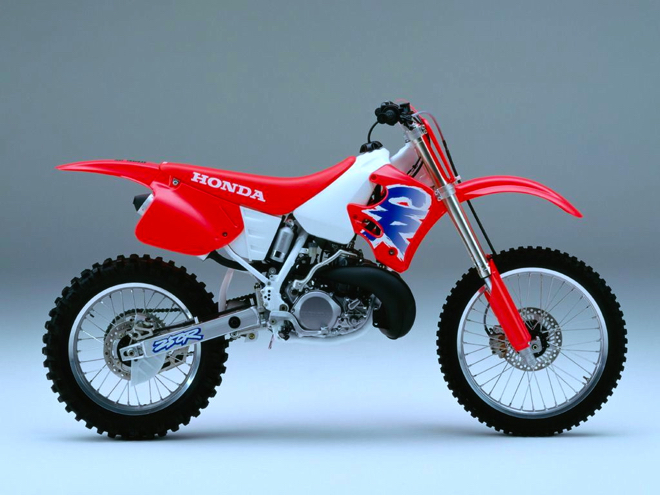 |
|
1993 Honda CR250R: McGrath’s personal favorite |
In the 250 division, refinement was the name of the game after introducing an all-new bike for ‘92. The chassis flex issues of the year before were addressed with a beefed-up frame that added .2mm of wall thickness to the backbone and head tube. The swingarm pivot was also strengthened by adding 1mm of material and reinforcements were added to all the frame members. Other than the frame reinforcements, most of the changes were minor for ’93. A revised intake tract and hotter ignition were paired with a new clutch with slightly increased oil volume. On the suspension front, Honda once again juggled fork taper size and damping in an effort to dial in some plushness. Unlike the 125, the 250 stayed with a Showa shock and offered revised damping and a 2mm larger shock shaft for ’93.
While all those changes were not earth shattering, they added up to a much-improved machine. The new frame gave the bike incredible turning prowess and a far more precise feel than ’92. The flex issues were gone and the bike could be placed exactly where you wanted every time. High-speed stability was still not in the cards, but for Supercross-style circuits, the CR was King. The motor continued to be the rocket of the class, with a muscular midrange and an endless top-end pull. The new intake and hotter ignition gave the bike a slight bump in low-end torque, but the bike continued to do its best work from the midrange on up.
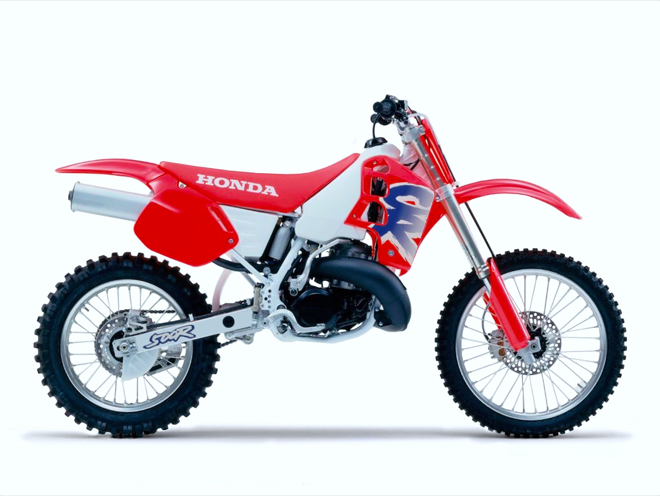 |
|
1993 Honda CR500R: Look, taller gearing! |
As in 1992, the suspension continued to be the CR250R’s Achilles heel and the new components proved only marginally better in the rear and actually worse up front. The new shock was plusher than 1992, but tended to blow through the stroke on big hits. Faster or heavier riders needed a bump up in spring rate and a revalve to keep the Showa damper from crashing to the stops on mega leaps. Up front, the new Showa forks were poorly set up, harsh, and impervious to easy fixes. Juggling spring rates and oil level did little to alleviate their poor action. Once again, the CR was the fastest bike, saddled with the worst suspension.
In the 80 and 500 class, changes were even more minimal for ’93. On the 80, updates were limited to the new plastic color, the deletion of the kickstand and BNG. On the 500, a taller fourth and fifth gear presumed to please the few lunatics willing to race the twitch-o-matic CR500Rs in the desert.
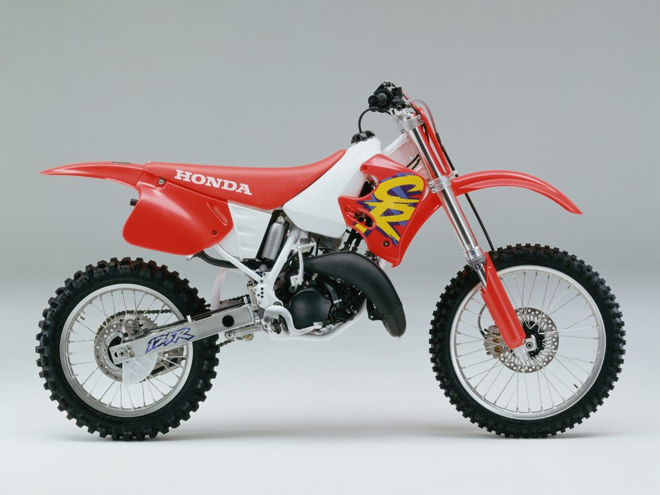 |
|
1994 Honda CR125R: Bold New Graphics, a slightly stronger frame and a switch to Kayaba forks highlight the ’94 Honda 125 package |
All-new in 1993, the CR125R received relatively minor upgrades for 1994. Probably the biggest of these changes was a switch to Kayaba forks. After the grim performance of the Showa units in 1993, this was looked on by most as a welcome change. Additional gusseting in the frame downtube and a longer and stronger swingarm were also added to further refine the red tiddler’s handling. Out back, the 125 retained the KYB damper of ’93 but added new settings to (hopefully) improve performance. On the motor front, a larger silencer and a set of T-vents for the carb were the only change for 1994.
As one would expect, these changes did little to alter the overall personality of Honda’s 125. The motor remained the fastest in the class with a strong hit and endless top-end pull. Handling was also little changed and the CR continued to be blissful in the turns and schizophrenic at speed. As it turned out, the switch to KYB forks only served to provide false hope to those wishing for a decent set of Honda forks. They were undersprung, underdamped, and prone to tooth-rattling metal-to-metal clanks on hard impacts. At least the KYB shock worked adequately and was not in danger of compressing your spine like the forks. Fun, fast, and once again, tragically flawed.
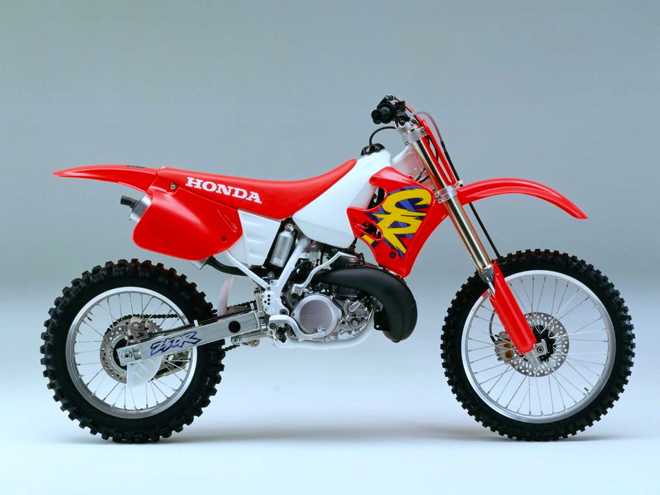 |
|
1994 Honda CR250R: A new chassis tames the shakes, but mutes the magic turning |
In 1993, the CR250R had proved a handful for some. The bike was blazing fast and turned on a dime, but its harsh suspension and wayward high-speed manors frightened those interested in something other than winning Supercross main events. For 1994, Honda decided they wanted to dial back a bit of that hard-edged focus and tame their thoroughbred. First up on the list was a new chassis that repositioned the motor, steering head and rider compartment. The new frame was once again stiffer and paired with a beefed-up swingarm that was 10mm longer. This new chassis offered a longer wheelbase and slacker steering angle in hopes of slowing down the CR’s high-speed oscillations.
In the end, this new chassis offered a different, but not necessarily better CR250R. The longer wheelbase and less-aggressive steering geometry did lessen some of the CR’s more frightening traits. The new bike was less prone to violent lock-to-lock swaps and not quite as terrifying at speed. Unfortunately, it was also not nearly as precise in turns. The new angles and weight distribution muted some of that magic Honda turning response and the bike was no longer the king of the inside line. It was far from a runaway train in the corners, but many riders lamented the loss of that effortless turning.
As for the rest of the bike, it was more or less the same poorly-suspended rocket ship it had been the two years before. Some minor porting changes smoothed out the power slightly, but not enough to make any real difference. The new fork and shock settings were once again out in left field and basically ineffectual at actually absorbing bumps. The forks hammered your wrists in the whoops and the shock kicked your tail in the stutters. Maybe next year…
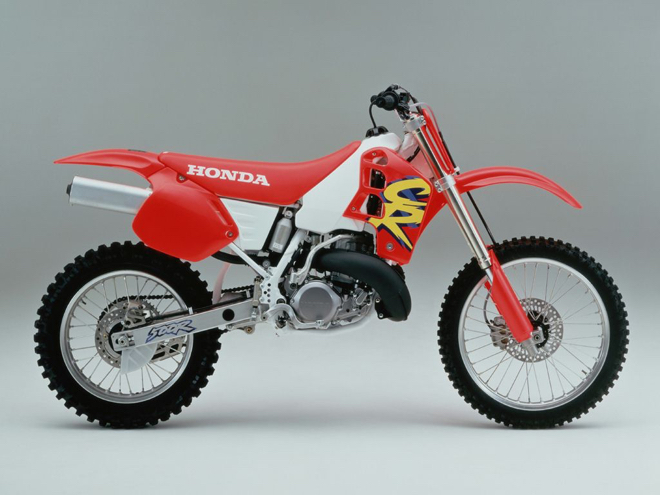 |
|
1994 Honda CR500R: Look a silver engine! |
Once again, the mini and 500 divisions receive only the most minimal of changes for 1994. In the 80 camp, the little Honda adopted a Dunlop K490/K695 tire combo and BNG. While in the 500 class, the biggest and baddest CR got a new coat of silver paint for the motor, a new reed-valve gasket and some stiffer springs in the forks.
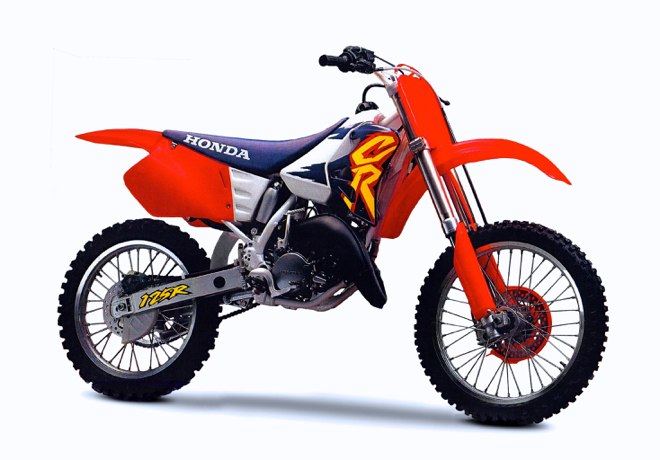 |
|
1995 Honda CR125R: Purple is the new black |
If you thought the switch to the Nuclear Red was a big change in 1992, it was nothing compared to what Honda had in store for 1995. After producing a damn fine looking motorcycle in 1994, Big Red went completely off the reservation for ’95 with the introduction of their new “Uranus Violet” (there is a joke in there somewhere, but I’m not going to touch it) bodywork and graphics. The new Uranus Violet (that’s purple to us normal folks) adorned the seat and shrouds of all the CRs and complemented (?) the new graphics that were actually bold for once. In addition to the new color, Honda spec’d new side plates (larger for you three-digit guys), a new front numberplate (more swoopy) and a switch to a 19” rear tire for the CR125R and CR250R. A new front disc guard was also added and all the full-size bikes got a welcome increase in footpeg width to 43mm.
Other than the new color palette, the biggest change for 1995 was the switch to Kayaba suspension for all the full-size bikes. For a few years, the CR125R had dabbled with KYBs, but for 1995, all the big bikes adopted the Showa rival. Considering Honda owned a large stake in Showa, this seemed like a somewhat surprising move. While the KYBs of the competition had regularly trounced the Showas on the CR250, the 125’s futility had proven the problem probably lay with Honda’s testers, not with the component’s manufacturers. This inconvenient truth aside, Honda plunged into the Kayaba waters with both feet for ’95.
In addition to the new look and new suspension, there were some other important changes on tap for 1995. The 125 received a new frame that beefed up all the tubing and repositioned the steering head to provide better stability. The new purple seat was also narrower at the tank and no longer taller than the one found on the CR250R. Motor changes were limited to a revised pilot circuit in the carb for improved throttle response.
Even with no real changes, the CR remained the fastest overall bike in the class. Its power was potent, fast-revving and demanding. It was great for pros, but most mere mortals preferred the broad and easy to use RM125’s snappy delivery. In the chassis department, the changes were far less successful. While the new suspension worked adequately (for once, the stock spring rates were in the ballpark), the new frame geometry was a major step backward. Just as it had done on the 250, the new frame angles muted the CR’s famous turning prowess. Even worse, it seemed to make the headshake problem worse, not better. The little Honda remained a competitive mount, but by most counts, the 1994 was a better machine.
 |
|
1995 Honda CR250R: New suspension, same results |
On the 250, the changes were more extensive. In addition to the all-new suspension, a new frame was spec’d that once again increased overall rigidity. A new steering head was 4mm larger in diameter and new clamps widened the fork mountings. Head pipe diameter was also increased to once again improve chassis stiffness. While the width of the tubing was increased, the new frame maintained the same somewhat controversial geometry of 1994. Motor changes were once again aimed at smoothing out the hit and pumping up the torque. New porting lowered all the ports slightly and a new expansion chamber decreased volume. Lastly, the spring rate was adjusted on the power valve to open later for a less-abrupt transition into the meat of the power.
On the track, the frame changes made little or no difference to the overall feel of the CR250R. It remained the same middle-of-the-road performer it had been in 1994. Turning response was good, but not great, and stability was mediocre, bordering on poor. The new motor settings didn’t really do much to change the CR’s delivery either, but that was not a bad thing. It remained the strongest-pulling (over the broadest range) motor in the class. It lacked the hard hit of the KX, but made up for it by pulling and pulling and pulling. Smooth, fast, and fun, the CR once again owned the title of best 250 motor in motocross.
On the suspension front, the new 43mm KYB forks performed just as bad as the outgoing Showas. The addition of stiffer springs out of the crate helped with the bottoming, but they continued to be harsh and less forgiving than the competition. They hammered, hacked and packed their way around the track. Even worse, a recall mid-year for improper heat-treating added injury to an already insulting situation. In effect Honda changed literally everything from the clamps to the supplier and ended up right where they started. Considering both Showa and Kayaba forks seemed to be working just fine on the green, white and yellow competition, the root cause was really starting to look like more of an internal testing issue than a supplier problem.
Out back, the situation was just as bad and the new KYB damper did the same hang-down, bang around and kick-like-a-mule dance as the year before. Under acceleration, it sucked down and hit a wall of damping, then wacked your backside on the first bump or ripple. It was spine–jarring and coccyx-bruising. Once again, the suspension tuners were counting the Benjamins as the new Hondas rolled off the assembly line.
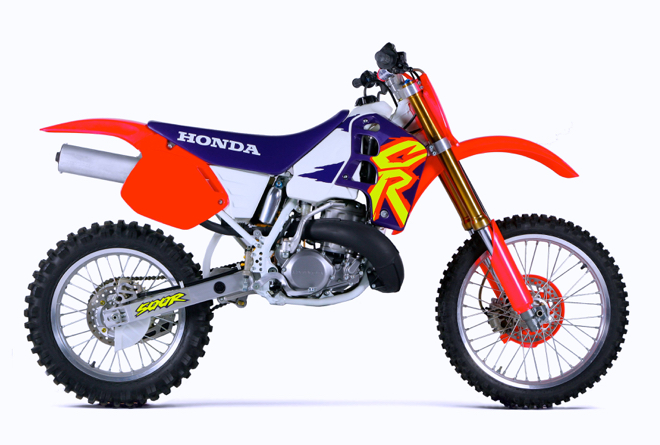 |
|
1995 Honda CR500R: Look, Uranus Violet! |
In the 500 class, all hope of a radically-new CR500R was beginning to look like a pipe dream. The demise of the 500 National class in 1993 and the overall migration of buyers to smaller and less-intimidating machines meant it was unlikely we were ever going to see a power valve equipped ultra-trick Open class Honda. For 1995, it did get the new purple plastic, wider pegs and KYB suspension, but no new bodywork or motor changes. At least they still made it, which is more than you could say for Yamaha or Suzuki.
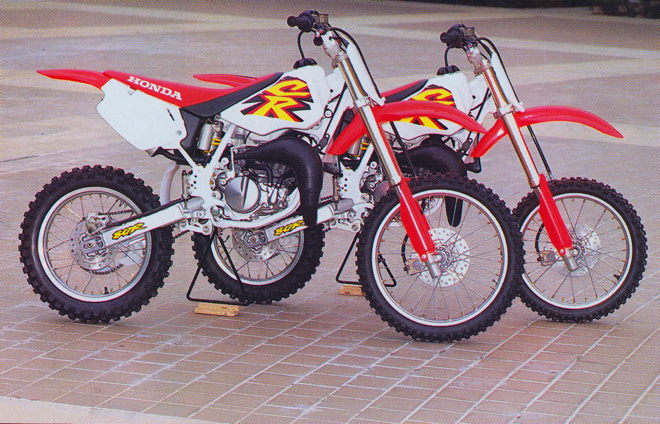 |
|
1996 Honda CR80R and CR80R Expert: Finally, a modern mini. |
By 1995, Honda’s CR80R was starting to look a bit long in the tooth. Even by the glacial standards of mini class development, the smallest Honda was behind the times. It was still plenty powerful, but its chassis was flexy, its suspension was wallowy and its looks were outdated. Compared to the ultra-trick YZ80, the CR looked like a bike whose time had come and gone.
For 1996, Honda set about rectifying that situation with the introduction of not one, but two new mini class entries. The all-new CR80R and CR80R Expert were clean-sheet designs that finally brought the red mini into the new decade. Both machines shared an all-new frame that retained the outgoing bike’s geometry, but increased rigidity by 40%. New 37mm inverted Showa cartridge forks were spec’d and paired with a larger fully-adjustable Showa shock. In the case of the Expert, a longer alloy swingarm was also added to complement the larger 19” front and 16” rear wheels. While available for a decade in other markets, this was the first appearance in America for a big-wheeled Honda mini.
Complementing the all-new chassis was radically redesigned bodywork that improved ergonomics and did wonders for the CR’s stale appearance. Ironically, about the only thing that was not new on the machine was the motor. In use since the mid-eighties, this 83cc powerhouse was more than fast enough for all but experts, but not as easy to ride as some of the competition. Without the benefit of a power valve, CR’s mill remained potent, but demanding.
 |
|
1996 Honda CR125R: Still fast, but the competition had closed the gap |
In the big bike classes, the changes were far less dramatic. All three bikes ditched the Uranus Violet of 1995 in favor of a much more tasteful red and black motif. There were also new bars (still steel), a new “knee brace resistant” panel on the seats, and a switch to silver for the lever perches. All three bikes also got a longer location bolt for the air filter and a switch to white for the number plates.
In addition to these changes, the 125 received some minor motor upgrades aimed at bumping up the CR’s lackluster low-end power. A new digital ignition was paired with revised porting, a slightly larger air boot and a lighter piston. On the suspension front, the 125 maintained the 43mm Kayaba forks of ’95, but added new, larger-cartridge units for improved damping. Out back, a new Kayaba shock incorporated a little works technology by adding high and low-speed compression adjustability for the first time.
While the CR was still a fast machine, 1996 finally saw its reign as the King of the 125 powerhouses come to an end. For several years, the competition had been nipping at its heels with broader (but less potent) power packages, but for ’96, Yamaha finally toppled the champ. The all-new YZ125 romped out of the hole and blasted through the midrange. It did not pull quite as far as the CR on top, but by that time, the YZ was gone. The Honda gave up a full horsepower to the Yamaha at peak and was exponentially harder to keep in the meat of the power. For a full decade, the CR’s high-strung powerband reigned supreme, but in 1996, it finally met its match.
As with the motor, the rest of the CR125R package was starting to show its age. The chassis continued to flummox riders with its unenviable combination of cranky steering and nightmarish headshake. The CR125Rs always shook like a wet dog, but at least the old ones shredded the turns. The new “more stable” chassis exhibited a push in the front end that would have been unthinkable only two years before. The new settings in the forks returned the same old results and the trick multi-adjuster shock only provided more ways to get hammered in the rear. For the sixth year in a row, the CR was saddled with the worst suspension in the class.
 |
|
1996 Honda CR250R: The end of the line for the steel-framed CR250 |
In the 250 division, Honda ditched the 43mm KYBs of ’95 in favor of an all-new 46mm unit pilfered off of the KX250. This fork had received many accolades on the Kawasaki, so there were high hopes this might be the magic bullet the front of the CR sorely needed. In the rear, the 250 also adopted the high/low adjust-o-matic shock of the 125 and added a few minor ergonomic details to increase comfort in the slightly cramped rider compartment. Motor changes were limited to a .7mm narrower exhaust port, a revised shift fork and change to digital control for the ignition.
As one would expect, these minor motor changes did little to alter the CR’s power personality. It remained smooth down low, brawny in the midrange and quasar on top. It offered the best shifting in the class and an absolutely bulletproof clutch. The KX250 pulled harder off the line and through the middle, but the CR pulled ahead as the revs climbed. For some, the Kawasaki’s grunt was preferable to the Honda’s long pull, but no one was going to accuse the CR of not having enough power.
The same could not be said of the CR250R’s front suspension, which continued to be an exercise in futility. Previous CR250 forks had been too softly sprung, prone to bottoming and harsh. Now the fork was too stiffly sprung, hard as a rock and harsh. For Supercross, the forks worked well, but for anything resembling real motocross, they were too stiff and unforgiving. The new shock turned out to be much better and most riders found it could be dialed in to their liking. Its action was stiff and it was better at hammering than cruising, but for hardcore motocross, it was raceable and the best Honda rearend in a decade.
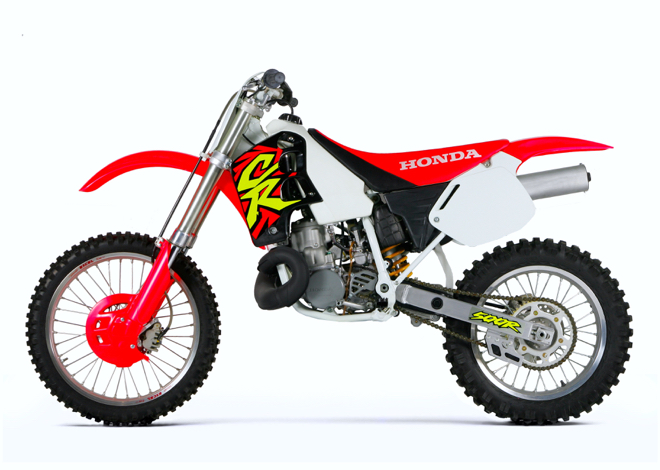 |
|
1996 Honda CR500R: New beefier forks and works-style shock were a welcome addition to the mighty 500 in 1996 |
In the Open class, Honda kept up its pace of incremental changes by giving the 500 the new suspension components off of the CR250R. Other than that, it was down to a new air filter cage and BNG for the Jolly Red Giant. Predictably, the stiff fork and shock of the 250 actually worked better on the powerful and heavy 500 and most people thought it was the biggest improvement to the 500 in four years.
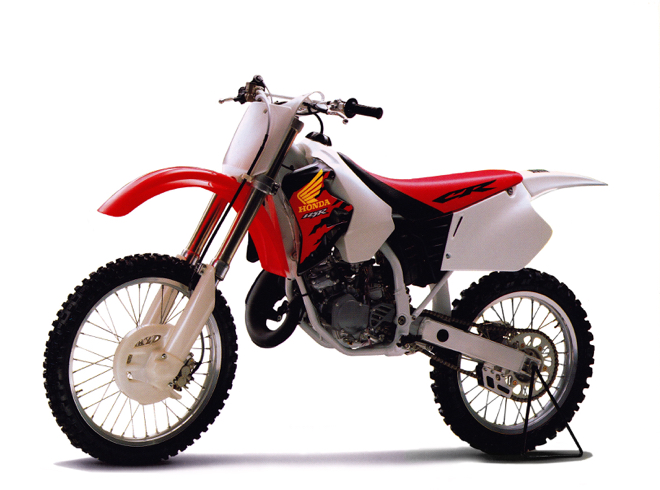 |
|
1997 Honda CR125R: The end of a dynasty. |
The 1997 season was a big one for Honda. After several years of speculation and dozens of prototypes, Big Red finally took the wraps off the first production motocross machine to use an aluminum alloy frame. The all-new CR250R broke ground by employing a road racing inspired twin-spar perimeter alloy frame and bolting it to the winningest power plant in motocross history. With its huge frame spars and radical new bodywork, the 1997 CR250R looked like no other machine on the track.
Crafted out of 7005 aluminum, the new frame used a combination of forged and extruded parts to make up its structure. Early on, Honda had experimented with some more conventional alloy frame designs, but decided in the end to go with the perimeter configuration because of its immense torsional strength. Weighing in at three pounds lighter than the steel 1996 frame, the new chassis helped Honda knock a full six pounds off the bike for 1997. While composed of an all-new material, Honda’s designers tried to keep the familiar CR250R feel by designing the new chassis to utilize the same geometry as the beloved 1993 CR250R.
While not as radical as the changes to the frame, the rest of the CR250R received major revisions for 1997. After two years of flirting with Kayaba suspension, the 250 was back on Showa for ’97. New 47mm “Twin-Chamber” cartridge forks replaced the 46mm KYBs of ’96. Similar to the much-heralded forks found on the ’94-’95 Suzuki RM250, these units once again aimed to take a bite out of Honda’s infamous mid-stroke harshness.
Out back, a new Showa shock was employed and paired with an all-new Pro-Link linkage that employed a more progressive curve for smoother performance. A new tapered swingarm was also added that increased strength, while once again lowering overall weight by 300 grams. Finishing off the rear was an all-new Nissin stopper that offered a more compact profile to save weight and a 20mm larger rotor for improved power.
Probably the least changed part of the ’97 CR250R was the motor itself. New porting lowered the intake ports 0.5mm and reshaped the exhaust sub-ports for better flow. A new flat-top piston was spec’d and paired with a reshaped head and all-new exhaust. The most interesting changes to the motor were the new “Power Jet” carburetor and high-tech ignition. The advantage of the Power Jet was that it provided a secondary fuel circuit to richen the mixture when needed, without affecting the overall mixture. A solenoid in the carburetor was attached to the CDI box, and under heavy loads, the Power Jet would squirt in a little extra fuel to increase power and response.
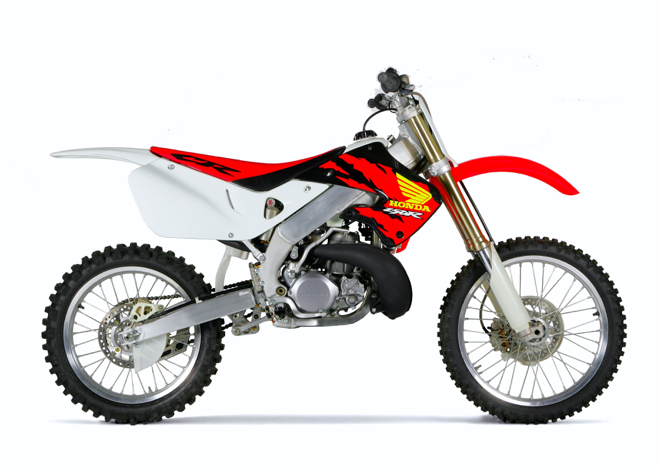 |
|
1997 Honda CR250R: The cutting edge cuts both ways |
The new ignition was just as cutting-edge as the carb and offered the first real application of traction control on a motocross machine. Using an eight-bit processor (just like your Nintendo Entertainment System), the ignition’s microprocessor checked rpm settings every 35 milliseconds and dialed back the ignition curve if it sensed a sudden change in engine rpm. Without a wheel-speed sensor and control over fuel delivery and braking, it was not going to be truly effective, but it was a step toward making motocross bikes easier to manage.
While there was absolutely no doubt the new CR looked trick, its actual effectiveness on the track turned out to be more dubious. The motor changes, though minor, resulted in a significant change in performance. Low-end power was down and the bike was sluggish off the line. It only came alive in the midrange, where the CR exploded in a rush of forward thrust. From there, it just kept pulling and pulling. Top-end power was the most abundant of any of the ’97 250s and the bike preferred to be revved rather than chugged. With its prodigious hit and lackluster low-end, the new traction control system had its hands full in 1997.
While the motor was not particularly easy to ride, it remained the best feature of the bike. The rest of the machine was too hard, too stiff and too much. That massively cool frame turned out to be about 45% too massive and imparted a harsh feel that transmitted every bump and vibration to the rider. Even though it was supposed to have the same geometry as the beloved 1993, it handled more like a ’96 CR with an underinflated front tire. There was an annoying push to the front end and a dead feel in the rough. It hammered and pounded into bumps the old bike floated over.
Not helping matters was the new suspension, which proved no better than the last nine variations had been. The Showa twin-chamber forks worked about 50% as well as they had on the Suzuki and the new Showa shock transferred every thud directly to your backside. Apparently, it did not matter what brand of components Honda actually bolted to their bike, they were going to end up with the same dismal performance regardless.
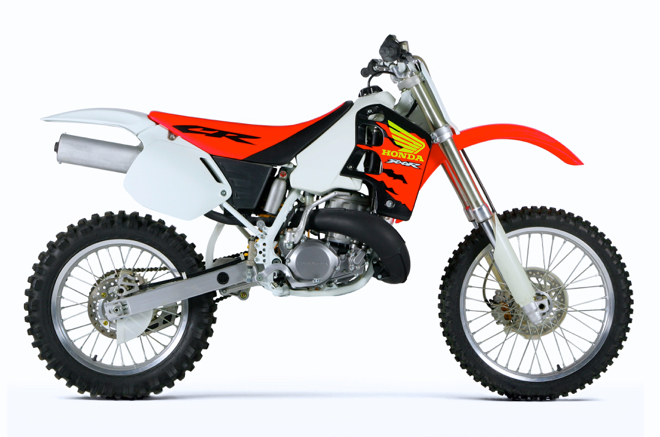 |
|
1997 Honda CR500R: Look, a white rear fender! |
While the 250 garnered all the attention in 1997, the 125 and 500 were better off for the neglect. Both retained the steel frames of 1996 and in the case of the 500, motored on into 1997 with only cosmetic updates. New white fenders and Factory Honda graphics gave the CR500R a new look, but underneath the BNG, it was an unchanged machine.
In the 125 class, the last of the steel-framed CR125Rs roosted into ’97 with a small list of important refinements. In the motor, most of the changes were aimed at improving reliability. A stronger third gear was added to the transmission, while a steel water pump shaft and stronger kickstart collar were installed. In an effort to catch up to the YZ125 and bolster the CR’s lacking low-end power, Honda remapped the ignition and lowered the overall gearing by going from a 14/51 to a 13/49 for 1997. While not really a fix, the lower gearing helped mask some of the CR’s lack of torque compared to the competition. Lastly, the 125 received an upgrade to the 46mm KYB forks used by the CR250R in 1996.
While the CR125R was largely the same bike that had dominated racing for a decade, its day as the only game in town had come to an end. It still produced the most top-end power, but its relative lack of torque made it much harder to ride than the brawny YZ and snappy RM. If you could keep it pinned to the stops it was blazing fast, but when you added in turns, off-cambers and tricky doubles out of corners, the others pulled ahead. On the bright side, both the new suspension settings and handling were improved for 1997. The slightly shorter wheelbase and improved throttle response caused by the change in gearing helped the bike snap around turns and the new forks and revised shock actually absorbed bumps for once. It also had the best brakes, clutch and build quality in the class. It may have been an old soldier, but it was a damn good old soldier. The days of Honda dominance in the 125 class had passed, but the CR125R still made an excellent mount for those with the skills and bravery to appreciate its virtues and work around its faults.
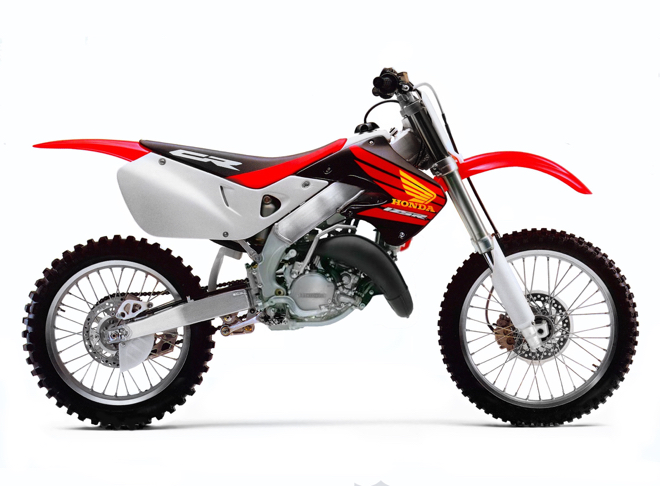 |
|
1998 Honda CR125: Five-speeds, an alloy frame and a sock in the airbox |
For 1998, the CR125R was the recipient of the all-new treatment from Honda. A new alloy chassis was crafted that was 50% stronger than 1996, while also being 15% less rigid than the one found on the CR250R. A new motor was also dialed up to better face the threat of Yamaha’s omnipotent YZ125. Where the old motor had fell short was in the torque department and the new ’98 power plant looked to address that deficiency with its biggest redesign since 1990. In order to boost torque, Honda spec’d an all-new cylinder, head and porting. There was also a new airbox, airboot, reed-valve and ignition. A reshaped HPP valve and all-new exhaust system finished off the top end, while a switch to a five-speedtransmission was requisitioned so each gear could be increased in size for better durability.
On the track, these changes turned out to be the death knell for a once-proud legacy. The new motor ended up accomplishing none of Honda’s performance goals, while also ruining its one great asset. Low-end torque was non-existent, as was the previously prodigious top-end rev. All of its meager power was located dead center, with nothing above or below this little rush of thrust. Compounding this problem was the new five-speed trans, which proved gappier than the old six-speed and harder for the anemic motor to pull. Many people surmised that the new alloy chassis was to blame for this neutering of a once great motor. The new airbox and airboot had to bend around those massive frame spars and the bike may have been gasping for air. Regardless of the whether it was the frame or the motor that was the problem, the end result was a CR125R that was incapable of outrunning a CR80R to the first turn.
The new chassis, while purported to be more forgiving, felt like the same lead-filled dud that the 250 was saddled with. It suffered the same vague steering, harsh feel and mind-numbing vibration as the bigger machine. The new suspension was decent, but nothing to write home to Lovely Louella about. The 46mm Kayaba bumper forks were very similar to the units found on the YZ125, but did not work as well as the ones on the Yamaha. They were generally too soft and blew through the stroke on hard hits. The Kayaba shock was not much better and suffered from the same “dead” feeling as the 250. This seemed to be a side effect of the overbuilt frame and no amount of re-valving and dial spinning completely eliminated it.
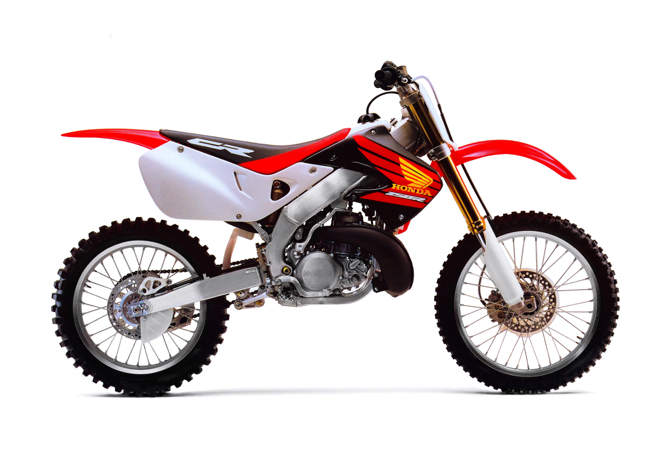 |
|
1998 Honda CR250R: Yogi’s chariot |
In the 250 division, the CR250R returned with only minor changes for 1998. Far and away the best-selling 250 of 1997, the CR had dominated the sales charts based more on its stellar looks than its actual performance. Most riders found it lovely, but harder to live with than the old steel model. For 1998, Honda looked to address some of the issues by refining the suspension and tweaking the geometry to increase rider comfort.
In this vein, Honda decided that most of the problems were actually with the suspension and not the frame. The engineers felt it was actually stiction in the forks that was the cause of their infamous mid-stroke harshness and the answer was to slicken them up for 1998. New thrust washers in the top of the fork allowed the springs to turn inside without binding and a new super-slick molybdenum coating was added to the inside of the tubes to reduce friction. A new cartridge system (still twin-chamber) was installed to offer smoother action and improved performance.
In the rear, a new Showa shock was installed that offered 5.8mm of increased travel and paired to an all-new rising rate linkage. The new shock offered a slightly stiffer spring for 1998 and revised damping to suit the new, more progressive linkage curve. In order to accommodate the new shock and linkage, Honda relocated the top shock mount slightly and changed the caster of the steering head to offset the slight increase in travel.
In the motor department, Honda stood pat for ’98 and offered the same basic package as ‘97. The only real change to the power package was a new intake boot (needed to clear the relocated shock) and some minor jetting changes aimed at boosting the CR’s lackluster low-end response. Other than a new chain roller and some factory–replica graphics, the rest of the CR250R was basically unchanged for 1998.
As one would expect with such minor changes, the 1998 CR250R offered basically the same love-it-or-hate-it package as the year before. The motor continued to offer the most top end and least torque in the class. Fast guys loved its endless rev, but mere mortals found it hard to get hooked up and tiring to ride. The chassis was still too wide at the pegs, bulging in the middle and heavy-feeling overall. The new fork and shock turned out to be different, but not necessarily better for ’98.
Attempts at softening the harsh feel of the bike resulted in settings that were too soft front and rear. Both the fork and shock blew through the travel and hammered to the stops on hard hits. There was virtually no damping control in either direction and even moderately fast riders found it scary to ride at speed. Between the incessant vibration, jackhammer forks, arm-stretching hit and buttocks-pulverizing shock, the 1998 CR was by far the most tiring bike to ride in the 250 class. It was still pretty, but under those matinee idol looks beat the heart of a sadist.
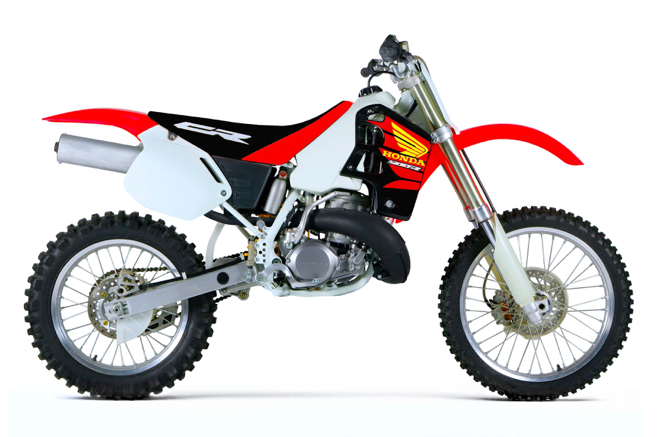 |
|
1998 Honda CR500R: Look, a red rear fender! |
In the 500 class, ah hell, just be glad there still is a CR500R.
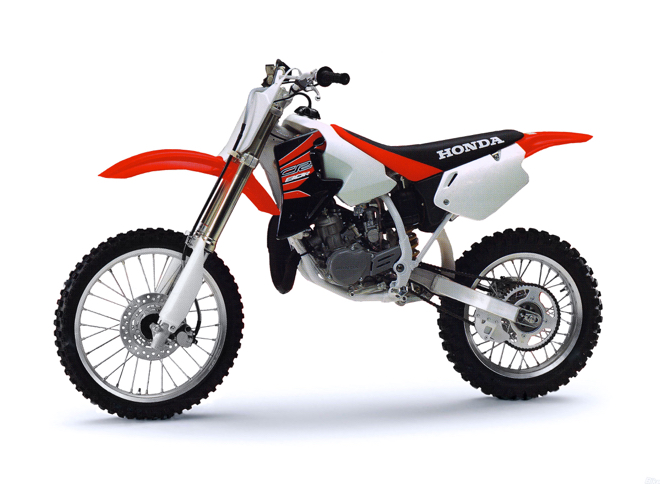 |
|
1999 Honda CR80R Expert: An all-new frame and revised suspension beefed up junior’s ride for 1999 |
For 1999, the often neglected CR80R and CR80R Expert actually led the charge of Honda changes. Both bikes received completely new frames (still made of steel) that offered 20% more rigidity than 1998. The new semi-double-cradle frame featured larger-diameter tubing throughout for increased strength and revised geometry to improve handling. There was also a new 37mm inverted fork and a new Delta-Link Pro-Link rear suspension to complement the frame. While the motor remained unchanged, it continued to be one of the fastest (and most challenging) mini motors in the class.
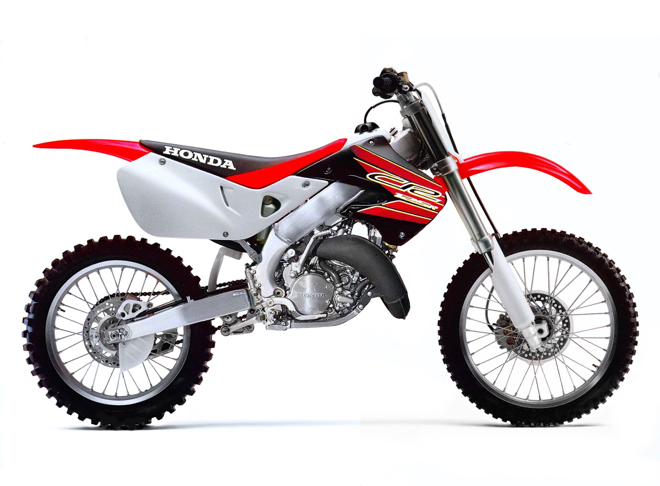 |
|
1999 Honda CR125R: The feel of a 250, the vibration of a 500 and the power of an 80 |
In the eighth-liter class, the CR125R finally got to move into the 90’s with an upgrade from NES (8-bit) to Super-NES (16 bit) for the ignition microprocessor. In addition to the fancier ignition, the ’99 CR125R received an upgrade to carbon fiber for the reeds, new jetting and a larger motor mount bolt. In conjunction with these less-than-earth-shattering motor mods, Honda dialed up a change in fork offset, stiffer fork springs, and new valving with a 2mm increase in travel. Out back, a new 1mm shorter shock was mounted and paired with a new linkage that offered a more progressive curve for ’99. Maybe most significant of all the changes, however, was a switch in seat foam density from rock hard to merely butt-bruising.
On the track, the ’99 CR125R proved to be the same frustrating machine it had been in 1998. The motor’s long lost top-end power was still MIA and the bike was harsh and tiring to ride. The bike buzzed, tingled and generally pounded you to a pulp. The forks were still underdamped and too easy to bottom and the shock hacked, thudded and hammered your backside in the rough. The brakes, components and build quality were still top-notch, but the CR’s performance lagged well behind every other bike in the class.
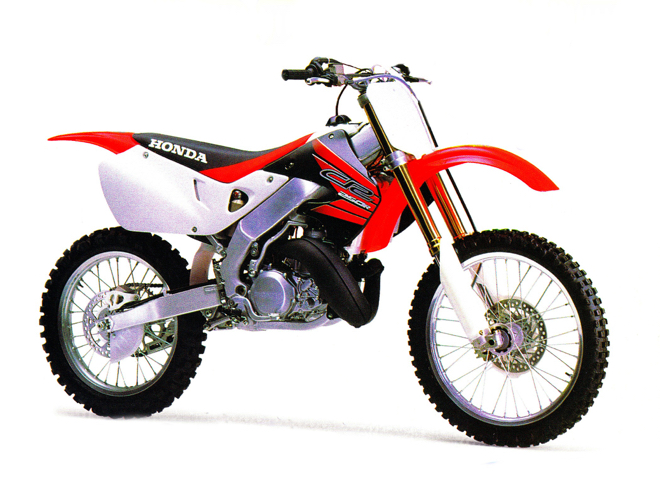 |
|
1999 Honda CR250R: Three strikes and you’re out |
In the 250 class, Honda tried to bounce back from the backlash of 1998. After dominating the sales charts in 1997, Big Red took a hit in 1998 after word got out about actually living with the alloy-framed wonder. Its harsh feel, jackhammer suspension and demanding motor were out of step with the current tastes in the 250 class. People wanted plushness and torque and the KX250 had that in spades.
For 1999, Honda tried to assuage some of these turned-off buyers by majorly revamping the CR’s 249cc power plant. A totally new cylinder, revamped power valve, reworked head and redesigned reed-valve highlighted the list of changes for 1999. The 250 also got the Sega Genesis (16 bit) microprocessor and interestingly, a switch in the carburetor away from the Power Jet design (Remember two years ago when this was the greatest thing since sliced bread? Yeah, forget that). All these changes were aimed at beefing up the CR’s lacking low-end and making the motor easier to ride.
Next up was the chassis department, where the new Hondas had received the lion’s share of the complaints. First to go were the marshmallow-soft suspension settings that riders hated in 1998. They did nothing to help the ultra-rigid chassis feel and only exacerbated the bike’s unforgiving nature. New stiffer fork springs and revised damping aimed to keep them up in the stroke and provide better feel. Out back, a new shock actually shortened the stroke for ’99 (Remember that awesome longer shock to provide more plushness in 1998? Yeah, forget that too) and in turn, relaxed the steering head angle and lowered the seat height slightly. Lastly, the CR250R received a much-needed set of rubber-mounted bar mounts and a switch to the same “more butt-friendly” seat foam the 125 received.
While it would not be fair to call Honda’s changes for ’99 a complete failure, they did not result in an appreciably better motorcycle. A few areas offered improvement, while others suffered major setbacks. First up on the fail list was the new motor; even with all the changes, that sought-after low-end power never really materialized. Even worse, the jetting was now screwed up. With the new carburetor, the bike liked to load up and sputter down low, before cleaning out in an explosion of thrust in the midrange. Once cleaned out, it pulled like a Saturn rocket, but only for a short span. Past the midrange, it petered and demanded a shift. That endless pull that had been the CR’s stock-in-trade for a decade was completely missing. It was short, punchy and powerful, but frustrating. Fast guys lamented its lack of top-end, slow guys had trouble with its monster hit, and everyone hated its finicky jetting.
While the motor changes were not well regarded, the suspension updates were better received. The new stiffer spring rates and revised damping kept the bike from crashing to the stops over every gum wrapper and the softer seat and rubber-mounted bars toned down the vibration and tailbone pain a bit. It still thudded, hammered and was in no way plush, but at least it no longer knocked out your fillings three times a lap. After three years of mild tweaks and Band-Aids, it was becoming pretty apparent the only way to get better handling and feel out of the alloy-framed CRs was a complete redesign.
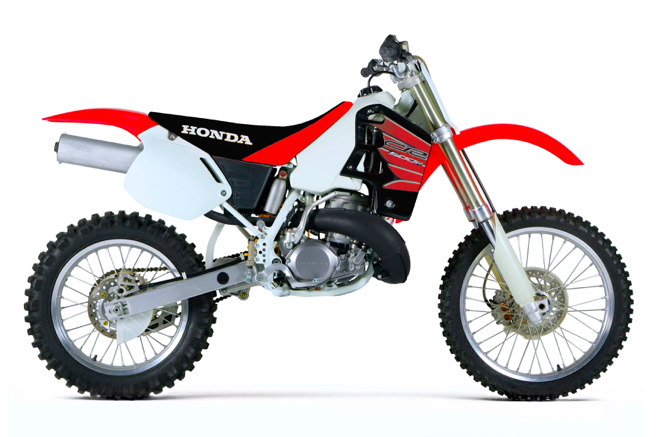 |
|
1999 Honda CR500R: Still big, still bad and in many ways, the best CR in the Honda stable |
With a motor from 1986 and a chassis from 1989, it was pretty damn ironic than the CR500R was actually the best-running and best-handling bike in the Honda lineup for 1999. Even with its dated ergonomics and stale looks, it was still plenty competitive in the right hands. By 1999, the Open class had fallen in love with Yamaha’s revolutionary new YZ400F four-stroke, but for those looking to mix their oil and have their wheelies too, the good old CR500R was hard to beat.
Next up, Honda Motocross History Part 4: The 2000s
For your daily dose of old-school moto goodness, make sure to follow me on Twitter and Instagram -@TonyBlazier
For questions or comments, feel free to drop me a line anytime at TheMotocrossVault@Gmail.com





